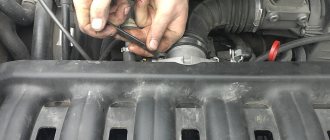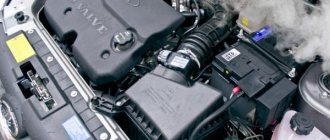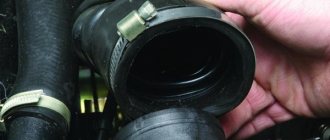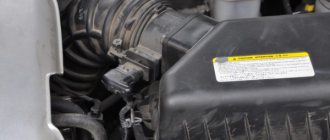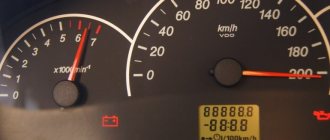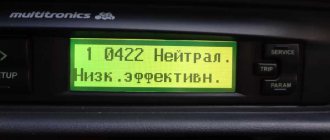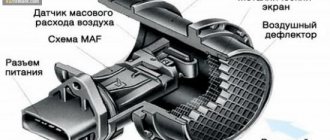Air leaks in the intake manifold are a common problem that manifests itself in unstable engine operation. Intake leakage leads to serious malfunctions; signs of air leakage in the intake manifold:
- the engine runs unevenly;
- the power unit shakes;
- RPM fluctuates.
However, it can be difficult to detect the area where air is being sucked in. For this reason, it is important to know how to check for air leaks in the intake manifold, as well as in the engine as a whole. Read more in our article.
Air leaks and its symptoms
The phenomenon of suction is associated with the penetration of air into the fuel tract of the machine.
It leads to a lean mixture and, as a result, greatly affects the operation of the engine, reducing its power and causing interruptions in operation. If air leaks occur in the intake manifold, the symptoms of the VAZ 2114 may be as follows:
- unstable idle speed;
- engine tripping;
- “sagging” during acceleration;
- increased gasoline consumption;
- difficult starting even at high air temperatures;
- a sharp drop in power (especially at speeds below 3,000 min-1).
If the engine stalls very often, this may also indicate that there is an air leak in the VAZ 2114. You can additionally verify the presence of this problem by using a car scanner. The presence of suction may be indicated by errors P0171 (very lean mixture) and P300 (misfire observed).
Stable engine operation at high speeds does not at all indicate the absence of suction, since it is most clearly manifested at low speeds. It is worth remembering this so as not to be misled and start looking for other causes of problems.
As soon as you notice that there are signs of air leaks, you should immediately begin searching for a possible place where it has entered the system.
Features of testing on carburetor engines
As we said above, the first thing you need to pay attention to on such engines if you suspect an air leak is the carburetor.
Check that all fuel flows through idle. To do this, start the car and disconnect the power wire from the solenoid valve.
If the engine stalls, the situation is simplified, since the valve is working. Remove it and unscrew the idle jet. Check the diameter of the jet hole; it should be 0.40 - 0.45 mm (see the characteristics of your carburetor). If the diameter of the jet is larger than according to the specifications, replace it.
Start the engine and try to set it to XX by unscrewing the EMC. If this cannot be done and it is felt that the engine does not have enough fuel, then it means that air is being sucked somewhere.
Pay attention to possible bending of the carburetor flange. To check whether air is sucking under it or not, pour water under it.
If the engine starts to stall, then the problem is in the bend. In this case, we do not use flammable liquid, it is so dangerous. See the video from Nail Poroshin for all the details.
How does air leakage affect the operation of the internal combustion engine?
For reliable operation of the internal combustion engine, a sealed air intake system is needed. This is necessary for accurate preparation of the fuel mixture. The engine control unit prepares the air-fuel mixture based on the readings of the mass air flow sensor (MAF). The air passing through the mass air flow sensor is counted and transmitted to the control unit, which sends a signal to the injectors and opens them and keeps them open until the required amount of fuel is supplied to create the correct mixture. This operation of the internal combustion engine is correct, but when unwanted air leaks appear in the engine after the mass air flow sensor, its volume increases.
It turns out that the air flow sensor transmitted readings to the ECU about the same amount of air passing through it, but in fact, due to suction, the air volume is much larger than it should be, but the ECU does not know about it. Because of this, the fuel mixture is formed incorrectly.
Signs of air leaks
Incorrect formation of the fuel mixture leads to unstable operation of the internal combustion engine and with this problem the following symptoms are observed:
- Difficulty starting the engine when cold after a long period of inactivity;
- Unstable idling, speed jumps from 500 to 2000 rpm are observed;
- Increased engine vibration at idle;
- Loss of power and former dynamics of the car; to accelerate the car you need to press harder on the gas pedal;
- Fuel consumption increases;
These signs indicate a problem with the vehicle and require a quick solution to the problem. It should be noted that these symptoms can arise for other reasons, but checking the engine for air leaks is one of the number one points in solving problems in the operation of the internal combustion engine.
Places where there may be suction
Air leakage can be anywhere where it passes to the combustion chamber, be it the intake corrugation or the receiver. There are several places where system depressurization occurs quite often.
Places of possible suction:
- Joints of the corrugation with the sensor and throttle assembly;
- Idle air control;
- Small breather;
- Vacuum brake booster;
- Absorber tubes;
- Injector rings;
- Intake receiver gaskets;
A few words about troubleshooting
It was possible to find an air leak in the VAZ 2112, 2114 engine, now it should be eliminated. The algorithm for eliminating the problem will be different, depending on the location of the gap. If the culprits are the clamps, tighten them. If this is not possible due to the hardness of the rubber pipes, it is better to replace them with new ones. Leaky gaskets are also replaced with new ones. In some cases this can be a time-consuming process, such as when replacing the gasket between the cylinder head and block.
For this, desire alone is not enough, since you will need to use a torque wrench to tighten the cylinder head bolts, a diagram for their installation and screwing. After a short run they will have to be pressed again. It will be a little easier to replace the intake tract gasket, but you will also have to dismantle and then reinstall a number of parts.
Advice! If this is the first time such an operation is performed, write down the order in which components and parts are removed. This will make them easier to install during assembly.
Mechanics have noted cases where VAZ 2112, 2114 power units had air leaks in the fuel rail. For some reason, VAZ manufacturers install a rubber hose, compressed with two clamps in the fuel supply system. After compressing them again, the problem usually goes away. Most often, replacing “outdated” rubber products in the intake tract solves all problems that have arisen.
It is much more difficult to eliminate malfunctions of intake tract sensors such as MVR, idle speed, and idle air control. We are not talking about replacing gaskets, but about sensor malfunctions, which can cause air leaks in the engines. Experts do not undertake to eliminate air leaks in these devices; they simply replace them with new ones. It is possible to repair conductive paths, eliminate contamination or oxidation. The appearance of air leaks in VAZ cars in the fuel system is accompanied by the presence of leaks.
Important! If the driver ignores the resulting fuel leak, there is a risk of a fire.
This may be the connection between the electric fuel pump and the fuel line, the fuel pressure regulator, and other places. Before starting work immediately after stopping the engine, you should relieve the pressure in the fuel system. Otherwise, fuel may escape and ignite.
This article is not a direct guide to action, it is for informational purposes only. It is difficult to describe all the possible causes of the problem and how to eliminate them. If readers have questions, watch the video: https://vk.com/video240089429_170844002
Symptoms of air leaks in the intake manifold of a VAZ 2114
All car engines, regardless of their type (with an injector or carburetor), operate on a mixture of fuel and air. The ratio of these components in the mixture is precisely calculated and regulated either electronically or mechanically.
But, sometimes it happens that additional air leaks occur, the mixture is “diluted” and the motorist can observe a serious loss of power in his car (which is especially noticeable at low speeds). We’ll talk about why this happens and how to correct this situation in today’s article.
“Suction” of foreign air into the carburetor
When foreign air enters the carburetor, the fuel mixture entering the car's engine cylinders becomes depleted.
The share of gasoline in it remains the same, but the share of air increases significantly. Such a composition simply does not ignite or ignites with difficulty and for a short time. Therefore, the engine may not start at all (either cold or hot), it may start and stall, unstable idling and “failures” are possible when starting off and in motion.
If the suspicion falls on the leakage of connections, seals and hoses, then it is necessary to check them as soon as possible.
General check for the presence of “suction” of foreign air into the carburetor
There is one effective way to check whether foreign air is being sucked into the carburetor. It is necessary to remove the air filter housing from it, start the engine, let it run for a while and then cover the top of the carburetor with your palm.
If the engine continues to operate with the air supply channels blocked, an attempt should be made to search for the location of this same “suction”.
If the carburetor stalls, look for the cause of the malfunction in something other than the “suction” of foreign air. Of course, this check does not claim to be exceptionally accurate, but in some cases it can help.
Possible places for foreign air to enter the carburetor
— Check how tightly the carburetor solenoid valve or the idle air system fuel nozzle holder is inserted in its place.
For a number of reasons, they sometimes get twisted and even lost. It is necessary to tighten the valve or holder, and if the engine begins to operate normally, by screwing or unscrewing the solenoid valve we achieve stable idle speed.
The fuel jet holder (on some carburetors is installed instead of the solenoid valve) must be screwed in with a little force.
solenoid valves for carburetors 2108, 21081, 21083 Solex and 2105, 2107 Ozone
It is also necessary to check whether the rubber sealing ring on the solenoid valve is damaged.
— Check the presence and condition of the rubber o-ring on the fuel mixture “quality” screw.
The image shows, as an example, a screw for adjusting the “quality” of the fuel mixture at idle speed of a 2107 “Ozone” carburetor with a rubber o-ring.
screw for adjusting the “quality” of the fuel mixture of the carburetor 2105. 2107 Ozone
— Check the tightness of the vacuum hoses
— From the ignition distributor (distributor) to the carburetor.
— From the vacuum brake booster to the intake manifold.
— Crankcase ventilation hose It is necessary to ensure that they are tightly seated on the fittings and that there are no cracks, cuts, punctures or abrasions.
Pinch the hoses near the carburetor fittings one by one and try to start the engine. If the air leak is blocked in this way, the engine will work normally. The image shows the location of possible “suction” of foreign air into the carburetor 2108, 21081, 21083 Solex.
places of possible “suction” of foreign air into the carburetor 2108, 21081, 21083 Solex of VAZ 2108, 2109, 21099 cars
— Check the tightness of the gaskets under the carburetor and intake manifold
If no gaps are visible visually and the whistle of sucked air is not audibly heard when the engine is cranked with the starter, then we try to tighten the carburetor and intake manifold mounting nuts. The tightening torque is 13 -16 N.m for the carburetor nuts, 21 -26 N.m for the intake manifold nuts. That is, there is no need to pull too hard, especially on a warm engine.
Tightening did not help, we remove the carburetor and change the gaskets, fortunately they are not expensive.
You can cover the connections being tested with soap foam or VD-40 liquid; a window will form at the point of “leakage” in the soap foam.
Vacuum hose repair
If your vacuum hose is damaged, you don't have to buy a new one. The hose is long. You can cut off the damaged part and reattach it to the engine.
The most common damage is at the ends of the tubes. Always ensure that the clamps are tight to prevent further leaks.
After repairs, start the engine and leave it idling. Listen for any hissing sounds.
If you decide to replace the vacuum hose, use one that is similar in length and diameter. Vacuum tubes are designed for specific locations, such as the brake booster or PCV (Power Crankcase Ventilation) system.
Symptoms of air leaks in the intake manifold and check
Air leaks in the intake manifold are a common problem that manifests itself in unstable engine operation. Intake leakage leads to serious malfunctions; signs of air leakage in the intake manifold:
- the engine runs unevenly;
- the power unit shakes;
- RPM fluctuates.
However, it can be difficult to detect the area where air is being sucked in. For this reason, it is important to know how to check for air leaks in the intake manifold, as well as in the engine as a whole. Read more in our article.
Possible places for leaks in the intake tract
True, for this you will have to either find or assemble a simple smoke generator. Smoke released into the intake system will instantly show the location of the leak with high accuracy. It is clear that not even every service station has a smoke generator, so you can assemble the simplest device yourself.
The flaw will become noticeable as soon as the smoke finds a place to escape.
The second method of determining the location of the leak is more labor-intensive and time-consuming. For this, a flammable liquid (ether, gasoline with a high octane number, liquid for quick starting of the engine in a can) is useful. To check and determine the location of the leak, just start the engine and spray liquid onto the manifold interfaces.
Sometimes the suction is clearly audible through a characteristic whistle or hissing, but this does not happen in all cases. Therefore, you need to methodically spray the liquid where the intake manifold meets the cylinder head and all the suspicious connections that we listed above. As soon as the liquid gets to the breakdown site, it will be sucked into the intake tract and the engine speed will increase sharply for some time.
other methods
There are several other methods for detecting suction. They consist in accurately measuring the vacuum in the area from the throttle valve to the combustion chambers, however, the equipment used to implement this method is not always available, and the accuracy of localizing the location of depressurization using this method is minimal.
FINE. You have problems with engine operation and you want to check where the system is sucking air or losing seals, where to start?
First, find the vacuum chart for your vehicle. You can find a copy of the vacuum diagram in your vehicle's owner's manual, but most car manufacturers include a diagram in the engine compartment. Lift the hood and look around the front of the engine compartment to locate the sticker.
If you can't find it in your manual or in your engine bay, you can purchase one from your dealer service department. Another source is your vehicle's repair manual, which contains all sorts of useful information that you can use to service and troubleshoot many vehicle systems. This way you will make a good investment.
A vacuum diagram shows the various vacuum controlled devices and their relationships. Newer car models display the similarities of components and their locations.
Signs of air leaks in the engine and finding the problem area
In modern electronically controlled internal combustion engines, the amount of air entering the cylinders is strictly taken into account by special sensors. But when the air flow finds an alternative path through a loose connection of parts, the normal operation of the power unit is disrupted due to a significant depletion of the combustible mixture. Determining air leaks in the intake manifold or other places is not an easy task; the symptoms that appear are too similar to many other problems. However, the problem of diagnosing this malfunction is completely solvable.
Symptoms of air leaks
Symptoms of engine air leaks are most often unambiguous:
- Uncertain start in the morning.
- Rough idle – idle speed fluctuates constantly and is below 1000 rpm. the engine may stall. On a car with a carburetor engine, the quality and quantity screw becomes insignificant for setting the XX mode since the air bypasses the XX channel.
- Power drop - in the intake tract on systems with MAF (mass air flow sensor) - low idle speed; on systems with a MAP sensor (absolute pressure sensor), on the contrary - increased idle speed, lambda errors, lean mixture, misfires.
- Increased fuel consumption - in order to start and continue driving, you need to constantly maintain high revs, while staying in a lower gear longer.
Diesel engines
In a diesel engine, diesel fuel enters the cylinders bypassing two fuel subsystems - low and high pressure. As a rule, it is in the low pressure area that air leaks occur.
This can happen through many pipeline joints, connections of fuel system elements, including the fuel injection pump.
The problem is aggravated by another point. To reduce the cost of producing diesel cars on modern models, instead of traditional brass tubes, plastic products are used, which wear out much faster.
Aggressive environment, vibrations, temperature changes - all this negatively affects their performance. This also applies to seals. As a rule, all this begins to manifest itself after 120-150 thousand km. mileage
Often, obvious leakage of diesel fuel when the engine is not running can indicate a problem area.
But when the car is running, when fuel is pumped from the tank, a pressure is created in the system that is lower than atmospheric pressure and therefore it is problematic to immediately identify air leaks.
Signs
The bottom line is that the mixture of diesel fuel and air entering the fuel injection pump when starting the engine does not allow it to perform its functions 100%, i.e. overloads it with a large amount of air in the fuel chamber.
When the car is already running, fuel enriched with air foams heavily and increases in volume. Therefore, at high speeds, the fuel injection pump does not have time to pass it through itself.
As a result, when you try to start a diesel car in the morning, you have to oil the starter for a long time, and you will see a little smoke from the exhaust pipe. And when driving or standing at traffic lights, the engine may stall due to insufficient diesel fuel entering the cylinders.
Causes
Causes of air leaks in diesel cars:
- Wear of rubber seals including fuel filters;
- Loosening clamps;
- Damage to the fuel tank;
- Wear and cracking of hoses;
- Damage in the return line;
- Wear of seals in the fuel injection pump cover, drive shaft, fuel supply lever axis.
Signs of air leaks
First of all, uneven operation of the internal combustion engine should be alarming. Symptoms of the malfunction are also:
- startup problems;
- loss of power;
- increase in fuel consumption.
The most appropriate word to characterize engine operation is instability. This is not a clear shudder of the engine when it “trips”, rhythmically falls on one leg. This is a random oscillation, more characteristic of idling. Sudden stop. Difficulty in adjusting: I’ve just adjusted the idle speed evenly, balancing the quality and quantity of the mixture, when suddenly everything starts all over again. And this is some kind of rubber hose from shaking, it opens a crack, then becomes sealed again. Unpredictability and inadequacy are characteristic of this disease, but there is an exception to this rule.
List of main reasons
Reasons why idle speed fluctuates
Incorrect operation of the power unit may be caused by a malfunction of certain elements:
- Failure of sensors:
- RXX;
- DMRV;
- DPKV;
- Lambda probe;
- DSA.
- The XX solenoid valve is faulty;
- The air filter is clogged;
- Heavy carbon deposits on candles;
- High-voltage wires are damaged or oxidized;
- Air leak in the intake manifold;
- Incorrect throttle position.
Air leak
When a car, when starting from a standstill (sharply), begins to choke for a second, and in some cases even stalls, this is 99% air leaks. Because excess air entering the engine cylinders causes a sharp leaning of the mixture and, as a result, difficulty in ignition. The engine runs rough and may stall at idle.
In this article we will learn to determine:
Sources
- White Jana Strategic Real Estate Portfolio Planning; Publishing solutions - M., 2022. - 289 p.
- Conformity assessment methods No. 2 2007; Standards and quality - M., 2007. - 961 p.
- Vitruk Nikolay Vitruk N.V. Volume 2. Monographs. Comments. 1963-1990; Higher school - Moscow, 1979. - 180 p.
- Boris Safarovich Ebzeev Man, people, state in the constitutional system of the Russian Federation. 2nd edition; Prospekt - M., 2022. - 205 p.
- Belousov Danila Customs law. Crib; Scientific book - M., 2009. - 349 p.
